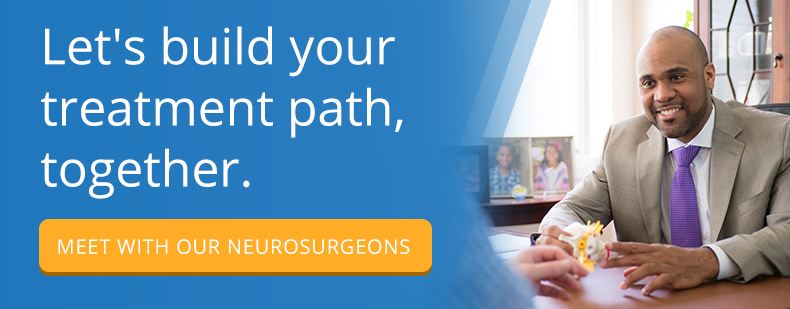A Chiari malformation is a developmental anomaly that forms before birth. As the body develops, the skull and brain grow together. The typical result is a perfect fit, with just enough room within the skull for the brain. In a Chiari malformation, the bones at the back of the skull do not grow large enough, and there is not enough space for the brain. As a result, the brain is displaced through the opening at the base of the skull, the foramen magnum, which can block the flow of cerebrospinal fluid (CSF) and impinge upon the spinal cord.
Nearly 1 in 1,000 people in the United States have a Chiari malformation. However, not all experience symptoms or are ever formally diagnosed. If you have recently learned you have a Chiari malformation, it can be helpful to understand more about your condition and how it is treated. The following information will help answer some questions you may have following your Chiari malformation diagnosis.
What are the Risks of Chiari Malformation Surgery?
There are two types of Chiari malformation surgery risks: general surgical risks and those related to the specific procedure itself. Your doctor will review the risks of Chiari malformation surgery in your individual case, but they can include the following overall surgical risks.
- Reaction to general anesthesia
- Bleeding
- Infection
- Blood clots
- Stroke
- Nerve damage, which can cause paralysis or weakness of muscles
Two risks specific to Chiari malformation surgery include CSF leakage and hydrocephalus (buildup of CSF). Hydrocephalus typically resolves on its own, but some cases require treatment by placing a small shunt to divert the fluid elsewhere in the body, where it can be resorbed.
Chiari Malformation Surgery Symptoms
Many patients do not experience Chiari malformation symptoms. However, symptoms can include the following.
- Headaches
- Neck pain
- Difficulty with balance and/or walking
- Trouble swallowing
- Muscle weakness or numbness
- Affected hearing and/or vision
- Vertigo
- Insomnia
- Sleep apnea
Chiari malformation surgery can help resolve these symptoms. Following surgery, you may continue to experience headaches as you recover, along with fatigue and nausea. However, these improve with time as your body heals.
How Much Does Chiari Malformation Surgery Cost?
There are different factors that will determine how much your Chiari malformation surgery will cost. Sit down with a financial specialist or similar employee at your neurosurgeon’s practice who can help you understand the costs involved with your procedure and your individual insurance benefits. It is important to factor in other considerations which are not part of your actual medical bills such as time off work.
Chiari Malformation Surgery Recovery Information
Your Chiari malformation surgery recovery will be a very individual process. Your personal doctor will be able to give you the most accurate idea of what to expect. However, having a general understanding can help you prepare mentally and physically for your recovery process.
Chiari Malformation Surgery Recovery Timelines
Many factors can affect your Chiari malformation surgery recovery timeline. That said, if you undergo a traditional surgical procedure, you can expect to spend up to a week in the hospital after surgery, followed by 6-12 weeks of recovering at home. During this time, you will be on activity restrictions, which are gradually lifted as your body heals. If you undergo a minimally invasive procedure, your recovery will be similar but briefer, with less time in the hospital and a shorter period of activity restrictions.
Does Chiari Malformation Surgery Leave a Scar?
If your treatment plan includes using a traditional surgical approach, you may have minor scarring at the incision sites. However, because these are on the scalp or the back of the neck, your hair will likely cover up any scars. Minimally invasive procedures have much smaller incision sites and disturb less of the surrounding soft tissues.
Life After Chiari Malformation Surgery
Following your Chiari malformation surgery, you will likely notice an improved quality of life as your symptoms resolve. Your personal doctor will be able to give you the most accurate idea of what you can expect in your particular case, but many patients experience symptom resolution following Chiari malformation surgery.
Sports After Chiari Malformation Surgery
Most patients are able to return to normal activity levels within 6-12 weeks of Chiari malformation surgery. However, if you were previously inactive because of debilitating symptoms, you may need to develop your strength before participating in activities after Chiari malformation surgery. Again, speak with your personal doctor about what to expect following your individual treatment.
How to Choose the Best Neurosurgeon for Chiari Malformation Surgery
It will be important to work with a neurosurgeon you are comfortable with, allowing you to rest easy before, during and after your Chiari malformation surgery. Some qualities you may wish to consider include:
- Experience treating Chiari malformations using both traditional and minimally invasive approaches
- A location close to home, limiting travel
- A practice with a patient-centric approach, providing individualized care
Ask people you trust for referrals, including friends, family and your general doctor. Many patients share their Chiari malformation surgery experiences online as well, providing another source of information.
Work with Your Personal Doctor
The information here provides a general overview of what many patients experience before and after Chiari malformation surgery. Continue the discussion with your personal doctor, who will be able to relate the information here to your individual case. Maintaining open communication is an excellent way to set your mind at ease as you move forward through the treatment and recovery process.


